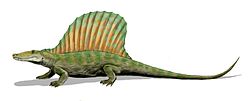| Xyrospondylus | |
|---|---|
 | |
| Holotype cervical vertebra at the University of California Museum of Paleontology | |
| Scientific classification | |
| Domain: | Eukaryota |
| Kingdom: | Animalia |
| Phylum: | Chordata |
| Clade: | Synapsida |
| Family: | † Edaphosauridae |
| Genus: | † Xyrospondylus Reisz, Heaton & Pynn, 1982 |
| Type species | |
| †Edaphosaurus ecordi Peabody, 1957 | |
Xyrospondylus is an extinct genus of non-mammalian synapsids belonging to the Edaphosauridae. [1] [2] The type species, X. ecordi, [3] was named in 1982; [4] it was originally named as a species of Edaphosaurus in 1957. [5]
It lived during the Pennsylvanian (Missourian) in Kansas and possibly also Colorado [6] and the holotype is known from a single cervical vertebra found in the Stanton Formation. A second specimen, consisting of a fragmentary pelvis, is also known. A third specimen, known from Colorado, is known, but it probably does not pertain to Xyrospondylus.





